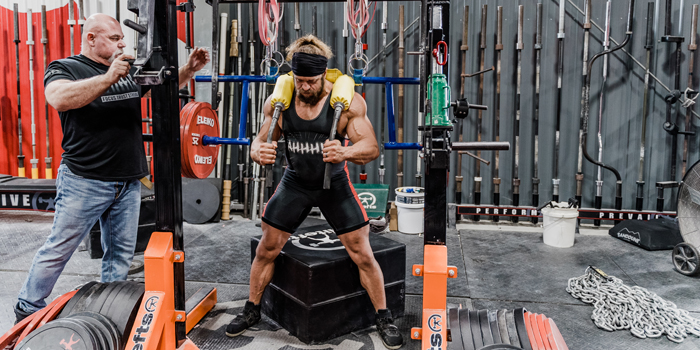
Right now is the greatest time for lifting information in the history of training. Yet, many lifters still look for hidden secrets via the Internet. There are no secrets left. Look to the lifters of yesteryear that could be found on the original World Strongest Man contests. Bill Kazmaier, Franco Columbo, Bruce Wilhelm, Fred Hatfield, and others showed the world how to do it no matter if you were an Olympic lifter, bodybuilder, or powerlifter. Many of the common themes these guys share are missing in the social media lifting of today.
RECENT: Fat Gripz—A Specialty Bar in a Gym Bag
1. Give It Time
In the time before the Internet, information traveled at the speed of magazine. Each month you got a new magazine in your mailbox. This was an exciting day and you would dive into it looking for any piece of information you could dissect to get better. There was a skill that was built in the study of the workouts and training information. You would then need to apply what you learned for the next four weeks before the next magazine showed up with updates.
This time frame required you to test out new training techniques or workouts for multiple weeks before changing to something new—no instant gratification, no flavor of the week, just time and work. This allowed for adaptations to happen before you gave up and changed to something new. This also allowed you to figure out what worked for your body and what didn’t produce results.
Use for Today
If you have new training ideas or exercises you must plan to give them time to work. Cycle them in for three to twelve weeks and then retest. Tweaks may need to be made to the exercise, volume, and intensity, but you have to do work before you decide to put it in the keeper or throwback file.
2. Connect via the Phone
In the late ’90s and even into the early 2000s, Louie Simmons had his home phone number listed at the bottom of his articles. It was awkward calling his home, but when he would answer your questions, it was like someone giving you a chance to cut to the front of the line. Many people were afraid to pick up the phone because he seemed like a wizard that would ignore those who needed help. The opposite was true. He would spend time on the phone with level zero lifters answering the same questions over and over. Even if had written 25 articles saying the same thing.
Use for Today
Today, with access to the best lifters and coaches at our fingertips, many are still afraid to reach out and ask for help. I can understand that some coaches are dickheads and want to get paid, but many will answer a question or two for free. Your call should not be to just get information. Respect their time. If they have a book for sale, support them. If they have articles written, read them. If there's something you don’t understand, then ask questions. It's about building relationships and connections. Start with people who are local that you can visit and train with.
3. Go Where They Are
Now that you have picked up the phone and built a relationship, getting into a bigger training circle is important. It doesn’t matter where your training schedule, level, or strength is at. No matter how bad you think you are, you need to go where the best lifters train. In the ’70s-’80s, you went to the strongest gym to be the best. There was gravity to these gyms. Sometimes they gathered in dungeons, garages, or even serious commercial gyms. These places are where technique, tips, tricks, and programs were refined.
Use for Today
Use a day trip to train at a more experienced gym—it'll pay for itself threefold. Building lifelong friendships and potential training partners will expand your access to more training information. If you bench 300 and you go train with four 500-pound benchers, you will know exactly where you lack in strength. If they can do 20 dips with 100 extra pounds, and you can only do 60 pounds, then you know your triceps are not up to speed. If they can barbell row 365 for eight clean reps and you can’t, then your lats are not strong enough to support 500. This day trip will accelerate your progress. Go where the strongest are to become stronger. Stop training alone!
4. Compete Against the Best
A plastic trophy or a sword for best lifter is cool but breaking personal records is the number one goal. Displaying your strength with higher stakes shows true grit and expertise. Travel, weight cuts, nutrition, and overall training will become even more important. Judging is often more consistent and has some sort of vetting process for bigger meets. There will still be mistakes made by judges but there will be fewer gifts, hopefully.
Use for Today
If you are competing at a national, world, or money meet, then winning will probably rank more important than overall numbers. Attempts will be chosen to put up the best total that will put you in the position to win. This mindset can only be learned by competing in those meets. Your goal should always be to compete against the best so that you raise your expectations of what strong really means.
5. Always Add Muscle
There seems to be a pattern of today’s lifters and it is to remain small. Weight moves weight and you need to improve leverages. Unless you are trying to break a world record or compete at a pro-level meet, you should keep adding muscle. Look at the mass monsters and even the lightweights of the golden era. They all looked like off-season bodybuilders or pro wrestlers. They didn’t try to hide into a normal body and lift weights. They grew into their strength and continued to grow.
Use for Today
Spend a year at a weight class and watch what happens to your numbers. Stop worrying about your coefficient and push your total instead. This doesn’t mean you have to eat like trash and add large amounts of body fat. It may equate to more rice, nut butters, meat, eggs, refeed meals, or cheat meals. After the year, clean it up and remove some fat but embrace the growth if you want to move monstrous weights. Get your weight up!
6. Train Specific with Crossover
The early WSM competitors had their specialty sports. Powerlifters, bodybuilders, Olympic lifters, throwers, pro wrestlers, and other disciplines all competed in the same competition. Everything they did was about strength and muscle. Some specific training for their sport was done but much was general and could be applied across multiple strength sports.
Each individual from every disciple had high levels of general physical preparedness (GPP). These were not strongman specialists. These athletes were at the highest level in their sport yet could compete due to their GPP.
Use for Today
Do not discount the simple task of being in shape with large amounts of general training. Be a better overall athlete.
I love the time we live in with instant access to information and people. This information should arm you with tools to be better but you can't be spoon-fed your whole life. At some point, you need to make a choice. Choose to be strong, figure shit out, and go compete against the best. Then, you will never settle for a plastic trophy you got for being the only person in your division.









